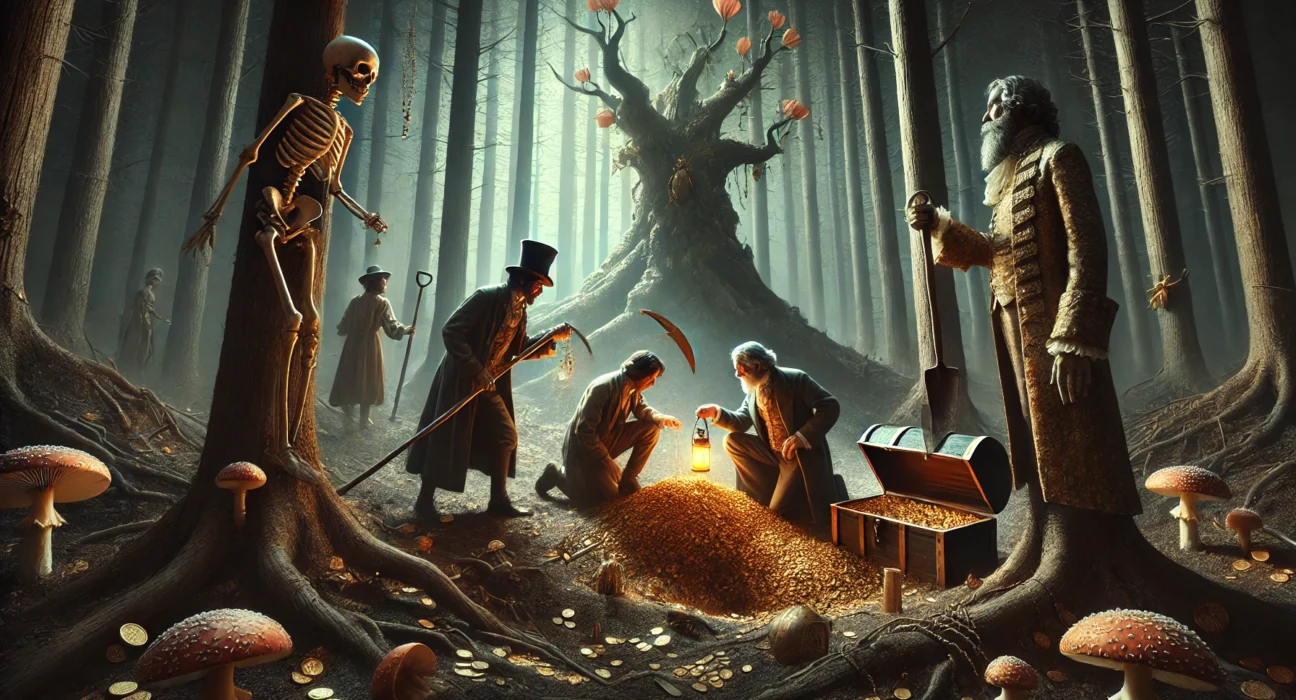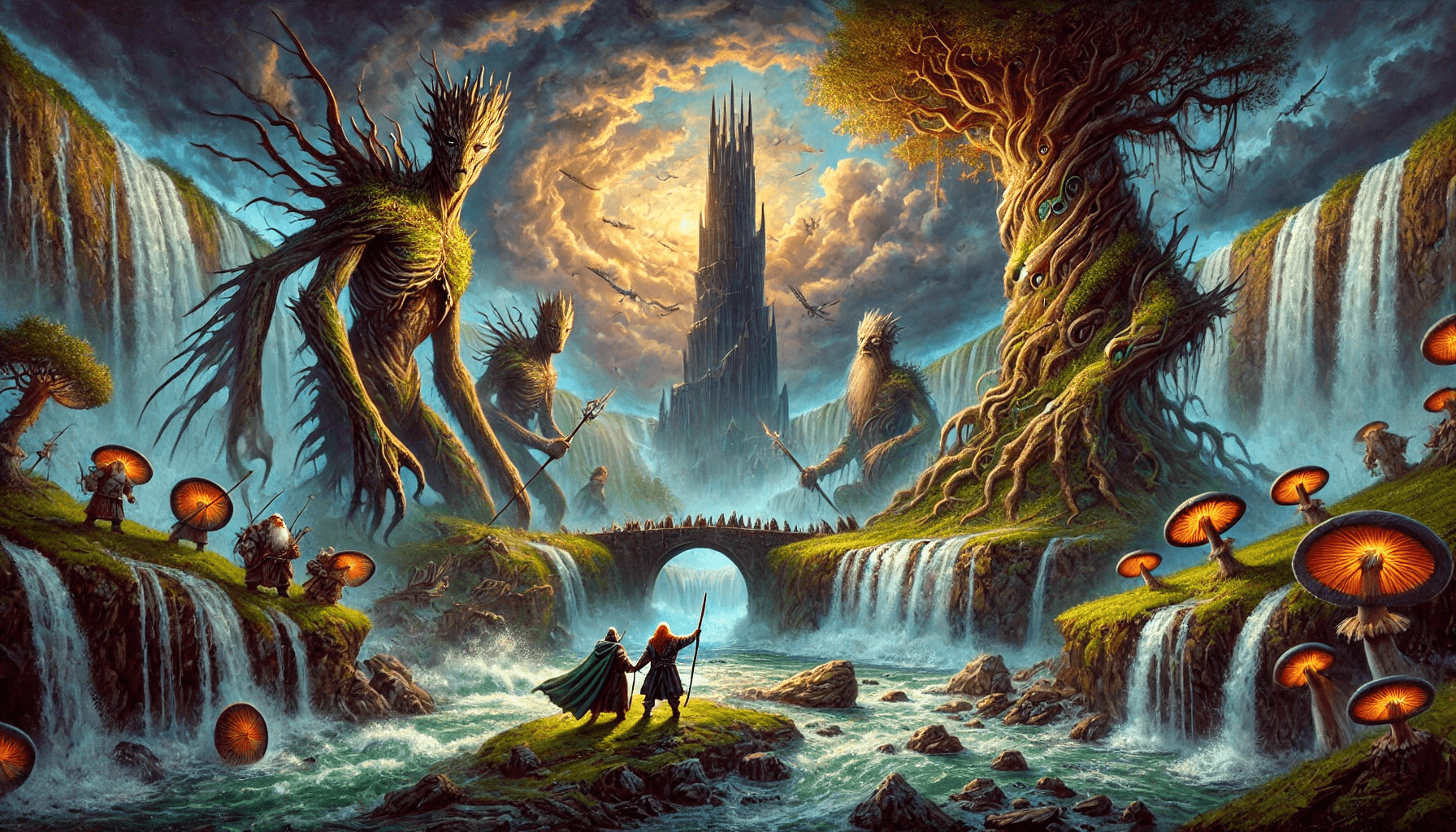The Gold-Bug by Edgar Allan Poe, published in 1843, is a thrilling story of mystery, treasure, and cryptography. This work combines elements of adventure and intellect as it follows the journey of William Legrand and his obsession with a peculiar golden beetle. Set on Sullivan’s Island in South Carolina, “The Gold-Bug” captures Poe’s mastery in weaving suspense with logic and adventure, making it a cornerstone in the realm of cryptographic and detective fiction.
Plot Summary
On the lonely shores of Sullivan’s Island, South Carolina, William Legrand finds himself in unexpected solitude. Once a man of wealth, now reduced by misfortune, he lives in a humble shack with only his loyal servant, Jupiter, by his side. Legrand’s days are spent immersed in nature, collecting shells and insects, with an eye for specimens that most others would overlook. Though genial, Legrand possesses a certain melancholy, and his moods swing between quiet enthusiasm and a dark, contemplative silence. Yet, it is during one of these walks that an event unfolds which would alter the course of his life: he stumbles upon a beetle unlike any he has seen before, gleaming as though it were fashioned from gold.
This remarkable beetle, with its golden hue and striking black markings, ignites an obsession in Legrand. He cannot shake the feeling that it holds a secret beyond its peculiar appearance. Eager to share his find, he invites an old friend, who lives in nearby Charleston, to join him at his cabin. But when his friend arrives, he senses something amiss with Legrand’s behavior, a fervor bordering on delirium. In a moment of whimsy, Legrand sketches the beetle on a scrap of parchment. To his friend’s surprise, the image, upon closer inspection, resembles a skull—a discovery that seems to transfix Legrand, his mind sparking with notions of hidden meanings and veiled messages.
Days pass, and Legrand’s obsession grows, driving him to reexamine the parchment. It is then he realizes that the parchment itself might hold a hidden message. Holding it close to the fire, he watches as heat reveals cryptic symbols etched into the fibers, symbols that pulse with possibility. To him, this is no ordinary find; it is a map, a path leading to fortune. His conviction of the beetle’s significance intensifies, and with feverish enthusiasm, he deciphers the symbols, unraveling a code that points toward a location hidden in the dense woods of the island.
Emboldened by this revelation, Legrand assembles a team—his friend and the ever-dutiful Jupiter—to embark on a journey into the rugged landscape. With Jupiter carrying scythes and shovels, they set off toward the mainland, navigating by the cryptic directions Legrand had decoded. The terrain grows more foreboding as they proceed, thickening with brambles and undergrowth that choke the path. At last, the cryptic symbols lead them to a towering tulip tree, majestic and ancient, its branches stretched high into the sky like silent sentinels.
Legrand instructs Jupiter to climb the tree, guiding him with sharp precision to a particular limb. Here, as directed, Jupiter finds a skull nailed to the branch—a haunting marker. Following Legrand’s orders, he threads the beetle, tied by a string, through the eye socket, allowing it to dangle below. With a sudden thrill of purpose, Legrand and the others mark the point where the beetle hangs, calculating its exact location below. They plunge a stake into the ground and measure an exact distance from the tree as indicated by the instructions in the cipher. Then, with shovels in hand, they begin to dig.
Hours pass as their efforts yield little but loose soil and buried roots. Disappointment hangs heavy, casting a shadow over their endeavor. But Legrand, fueled by a fierce determination, insists on a second attempt, this time recalibrating the digging spot with meticulous care. With renewed zeal, they return to their task, the oppressive night deepening around them as their shovels bite into the ground. Then, just as exhaustion threatens to claim them, their labor is rewarded. Their digging unearths the remains of human skeletons, fragments of decayed clothing, and finally, something solid and gleaming—a buried chest.
With hearts pounding and breath held in suspense, they pry open the lid. Within lies a fortune that defies belief: heaps of gold coins, glittering jewels, ancient silver artifacts, and treasures amassed beyond measure. Precious stones spill over, illuminating their faces in the dim light of their lanterns, an awe-inspiring bounty hidden for countless years beneath the island’s soil. Legrand’s hands tremble as he lifts coin after coin, recognizing pieces of old Spanish currency and jewel-studded ornaments, the wealth of a long-dead pirate’s hoard.
Overwhelmed by their discovery, the three men load as much as they can carry and, exhausted but elated, return to Legrand’s cabin. Only when dawn’s light filters through the trees do they rest, consumed by thoughts of the vast fortune they have unearthed. In the days that follow, they carefully catalogue the riches, piecing together evidence of a legendary pirate’s fabled fortune, long thought lost to the ocean’s depths and the passage of time. Among the items are centuries-old crucifixes, jeweled swords, opulent chalices, and gilded goblets that speak to a bygone era of adventure, conquest, and ruthless ambition.
Yet, even as they revel in the treasure’s allure, curiosity demands satisfaction. Legrand, finally at ease and relieved of his obsession’s weight, reveals to his friend the intricate workings of the cipher he uncovered. In his eyes, the true triumph is not the treasure itself, but the journey that led to its discovery. The cryptographic symbols he decrypted hinted at specific locations, distances, and details so minute that only a mind tuned to hidden patterns could decipher them. What seemed like madness to others was, for Legrand, a testament to his skill, patience, and persistence—a triumph of intellect over doubt.
The golden beetle, with its captivating sheen, becomes the centerpiece of his triumph. It led him on a journey of risk and reward, transforming the misfortunes of his past into a future gilded with wealth and security. In the treasure, he finds more than gold; he finds vindication, a proof that his isolation and eccentricities held purpose. His friend, too, shares in this newfound fortune, his skepticism replaced by admiration for Legrand’s ingenuity and perseverance.
As days turn into weeks, the three men adapt to their newfound wealth, each irrevocably changed by the golden beetle’s mystery. For Legrand, the treasure was never simply wealth buried beneath the ground; it was the unraveling of a cipher, a test of the mind’s resolve against the mysteries of the world. And as the final coins are counted and the jewels stowed away, the memory of the golden beetle lingers—an insect of extraordinary brilliance, a symbol of discovery, and the key to an unimaginable fortune hidden away by time and sand.
Main Characters
- William Legrand: A passionate, eccentric recluse from a formerly wealthy family, now living in near isolation. Legrand’s fascination with the golden beetle propels him on a quest for hidden treasure, revealing his intelligence, resourcefulness, and determination.
- Jupiter: Legrand’s loyal servant, a freed Black man who remains dedicated to his “Massa Will.” Superstitious yet dutiful, Jupiter adds humor and humanity to the story as he navigates his master’s bizarre pursuits.
- The Narrator: A friend of Legrand’s, whose perspective guides the reader through the unfolding mystery. Though skeptical of Legrand’s sanity, he is drawn into the adventure and ultimately serves as a sounding board for the logical steps leading to the treasure.
Theme
- Obsession and Madness: Legrand’s fixation on the golden beetle and his cryptic clues seem to border on madness, leaving others to question his mental stability. This theme examines the fine line between genius and madness, a recurring motif in Poe’s work.
- The Pursuit of Knowledge: “The Gold-Bug” explores the power of intellect and logic, as Legrand’s cryptographic skills unravel a complex code leading to treasure. The story celebrates intelligence and persistence, emphasizing how knowledge can unlock unimaginable rewards.
- Race and Loyalty: Through Jupiter’s character, Poe subtly addresses issues of race and loyalty. Despite being a freed man, Jupiter remains by Legrand’s side, showcasing his steadfast loyalty and a bond that defies societal expectations.
- Adventure and Discovery: The story’s treasure hunt motif reflects humanity’s age-old fascination with exploration, adventure, and the rewards of perseverance, evoking a sense of discovery and the allure of the unknown.
Writing Style and Tone
Poe’s style in The Gold-Bug is both meticulous and vivid, characterized by detailed descriptions and a narrative that balances suspense with logical progression. His writing mirrors Legrand’s precise and methodical approach to solving the mystery of the golden beetle, creating an atmosphere of gradual revelation. Poe’s sentences, rich in descriptive language, allow readers to visualize the eerie isolation of Sullivan’s Island and the excitement of the treasure hunt.
The tone is one of suspense and mystery, underscored by moments of humor and levity, especially through Jupiter’s superstitions and reactions. Poe creates a subtle unease, leading readers to question the line between brilliance and madness as they follow Legrand’s cryptographic challenge. The story blends the thrilling nature of a treasure hunt with the intellectual rigor of code-breaking, making The Gold-Bug a unique narrative of intrigue and discovery.
We hope this summary has sparked your interest and would appreciate you following Celsius 233 on social media:
There’s a treasure trove of other fascinating book summaries waiting for you. Check out our collection of stories that inspire, thrill, and provoke thought, just like this one by checking out the Book Shelf or the Library
Remember, while our summaries capture the essence, they can never replace the full experience of reading the book. If this summary intrigued you, consider diving into the complete story – buy the book and immerse yourself in the author’s original work.
If you want to request a book summary, click here.
When Saurabh is not working/watching football/reading books/traveling, you can reach him via Twitter/X, LinkedIn, or Threads
Restart reading!








